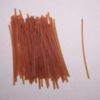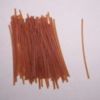The old British cartridges were tapered because they were first loaded with stick cordite powder.
Which closely resembles uncooked spaghetti.

The only way they could get it in the case was by using the slight taper of the .300 & .375 H&H.
That or put the cordite in the case and then form the shoulder later like they did on the .303 British.
That is also why they first used a belted case to headspace from.
Because there was no shoulder, and unlike the 303, and they were rimless cases..
A side benefit was the slickest feeding of any cartridge design since, & easy extraction.
rc



